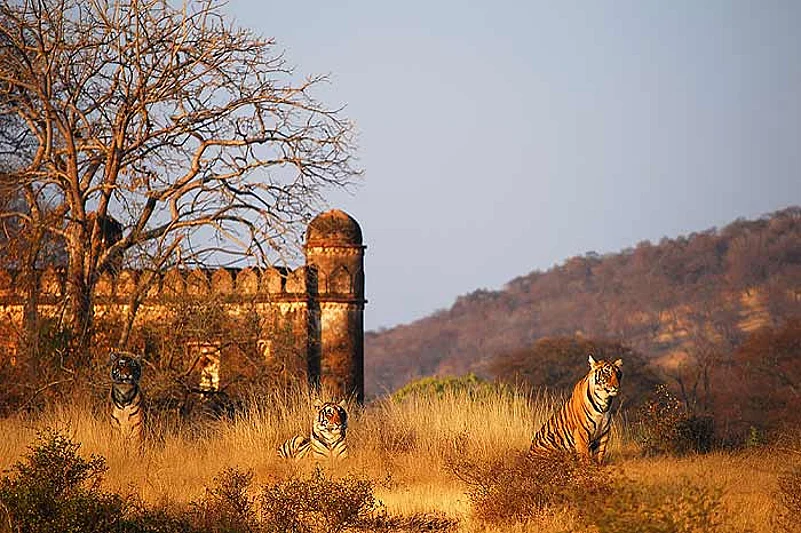At first glance, Ranthambhore: The Tiger’s Realm might come across as just another run-of-the-mill picture book of an animal that is woefully close to extinction. But a closer examination of the book reveals a world that has been intricately captured by three completely different people who look at the domain of the tiger within the confines of our own world, bringing to bear their own unique perspectives on what they contend is the Jungle King’s realm. To that end, this book, written and produced by Priyanka Gandhi Vadra, Anjali and Jaisal Singh, brings to life not just the tigers of Ranthambhore, but, equally, the legacy Indians have inherited and their interpretations of what this legacy heralds.
There are no stories that are either trite or for that matter predictable. Nor is the book a tourist’s guide to the abode that Ranthambhore has become for the King of the Jungle. Indeed, it is a celebration of Ranthambhore! And is a poignant and very personal account of three individual journeys into the heart and mind of the tiger as also the wildlife that it shares Ranthambhore with. So what the reader imbibes is not just the tiger’s world, but far more importantly what that world means to three very ordinary people who are passionate about both the tiger and the shared interplay between the tiger and the worlds they live in. That is the essence of this magnificently produced book. But the book also transcends the personal and moves on to the families of the authors and the myriad colourful animals that call ranthambhore home. The splendid stories of the tigress sisters, Shadow, Brat, Split, and other tigers like Zaalim, Junglee and Macchli are reminiscent of Rudyard Kipling’s jungle musings.

Tiger see, Tiger do Priyanka doing her best tigress act, pouncing on an unwary Rajiv
There are many things to love about the book. Its pictures are arresting: the photographs seem to reflect the real habitat of the tiger and the other animals or the very personal diary accounts and anecdotes that the authors share at the end of the book or even the narrative, which is both precise and yet very moving. But what I found the most pleasing were the captions ascribed to the pictures. You can savour the innocence of the words: there is none of the ethereal wordplay that can, at times, feel glaringly unnatural and yet is so abused in books that belong to this genre. They are captions which don’t simply capture the image’s being. By themselves, they tell a story of the person behind the lens. This could so easily have been a book that might be tucked away as a personal rendering of the many visits—or consigned to being just one more memory of the many holidays that a group of three friends have taken to a place that has attracted Presidents and commoners alike. Instead, the deeply historical anecdotes permit sneak peeks into the families of the three authors and their long-standing association not only with wildlife but with ranthambhore—the last word in wildlife conservation.

Brat and Split settle a territorial dispute
In their narratives, the troika’s passion for and their engagement with the tiger, not simply as an animal but also as a symbol of legacy and majesty, comes through. What is equally delightful is the crispness with which the tales unfold. There is no overbearing preaching, no value judgements. The personal accounts serve readers an all-too-rare glimpse of the excitement and the delight that one experiences in the jungle. It is this facet of the book that differentiates—and even sets it apart—from the several hundred pictorials that one might come across about the tiger.
The diary accounts, apart from being personal, are written sans agenda. And thus, exude honesty and compassion. Priyanka Gandhi Vadra’s family has had a tryst with nature and wildlife for decades, and it shows in the manner in which Priyanka pens her thoughts. A diarist who forces no views of her own but instead allows the reader to enter that intensely private world through which the long-standing affair with nature comes alive. The prose which Priyanka injects into her essay reveals a rare sensitivity in someone so young. The family album related to Ranthambhore is a delight to peruse—besides being of no small historical interest.

Queens of the realm Macchli is out for a drink
Anjali Singh’s craft as a painter is borne out by the manner in which she captures the tiger on canvas, breathing new life into a dying species. Her rendition arrests readers with both its visual sensitivity and piercing prose.
Jaisal Singh’s career as a hotelier may have begun in the tiger’s backyard, but his yearning for the retention of the tiger’s majesty and its survival is not a product of his business zeal. Rather, it’s a burning passion, the resoluteness of which has neither wavered nor diluted.

Priyanka and Anjali Singh
In many ways, this book defies definition and allows the reader to treat the eyes, the mind or both. It fosters entry into three private worlds where the only commonality is an unabashed love (and admiration) for the tiger. In many ways, this book is a tribute not just to the tiger but also to simple human beings who have, on one level, engaged with the tiger and, on the other, have the ability to weave magic through tales that would never have surfaced—let alone be captured—in a book.
The oft-repeated quote: ‘a picture says a thousand words’ is perhaps irrelevant to this book. Where it is successful is in transmitting tales that jump out not just from each picture but more from each word. Which is why this is a commendable, and if one might add, memorable effort. A book that will easily transition from the coffee table into many hearts.


























